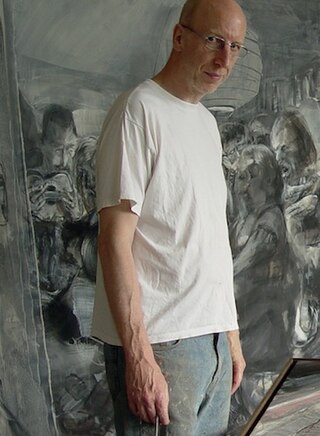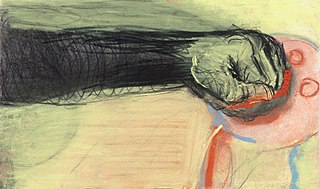Eberhard Havekost was a contemporary German painter based in Berlin and Dresden, who exhibited internationally.
Ena Swansea is an artist based in New York City. Her paintings often take memory as a point of departure.

Ralf Winkler, alias A. R. Penck, who also used the pseudonyms Mike Hammer, T. M., Mickey Spilane, Theodor Marx, "a. Y." or just "Y" was a German painter, printmaker, sculptor, and jazz drummer. A neo-expressionist, he became known for his visual style, reminiscent of the influence of primitive art.
Tomma Abts is a German-born visual artist known for her abstract oil paintings. Abts won the Turner Prize in 2006. She currently lives and works in London, England.

Norbert Bisky is a German artist based in Berlin. He is one of the most important representatives of a new figurative painting in the 21st century.
Caro Niederer is a contemporary artist who lives and works in Zürich.

The Berlinische Galerie is a museum of modern art, photography and architecture in Berlin. It is located in Kreuzberg, on Alte Jakobstraße, not far from the Jewish Museum. The Berlinische Galerie collects art created in Berlin since 1870 with a regional and international focus. Since September 2010, the museum's director has been the art historian Thomas Köhler, until then deputy director, succeeding Jörn Merkert.

Johannes Heisig is a German painter and graphic artist. His work combines the tradition of German socialist realism with a subjective expressionism. He portrayed several famous German politicians such as Willy Brandt, Johannes Rau and former Finance Minister Peer Steinbrück. The artist is represented by galerie son, Berlin.

Michael Schultz was an internationally active German gallerist. Michael Schultz Gallery / Galerie Michael Schultz operated in Berlin, Germany, Beijing, and Seoul. Thus he ran four galleries on two continents. The galleries provided cultural exchange, as Asian artists are shown in Europe and vice versa. The Galerie Michael Schultz GmbH & Co.KG was dissolved on November 7, 2019 due to the opening of insolvency proceedings. Schultz died of a brief serious illness on December 28, 2021.

Miriam Cahn is a Swiss painter.
Channa Horwitz was a contemporary artist based in Los Angeles, United States. She is recognized for the logically derived compositions created over her five-decade career. Her visually complex, systematic works are generally structured around linear progressions using the number eight.

Renate Bertlmann is an Austrian feminist avant-garde visual artist, who since the early 1970s has worked on issues surrounding themes of sexuality, love, gender and eroticism within a social context, with her own body often serving as the artistic medium. Her diverse practice spans across painting, drawing, collage, photography, sculpture and performance, and actively confronts the social stereotypes assigned to masculine and feminine behaviours and relationships.
Seo Soo-Kyoung, known by the artist name SEO (세오), is a South Korean contemporary artist who lives and works in Berlin, Germany. Her artist name comes from her family name Seo written in capital letters.
Max Uhlig is a German painter. He won the Hans Theo Richter-Preis of the Sächsische Akademie der Künste in 1998.
Parastou Forouhar is an Iranian installation artist who lives and works out of Frankfurt, Germany. Forouhar's art reflects her criticism of the Iranian government and often plays with the ideas of identity. Her artwork expresses a critical response towards the politics in Iran and Islamic Fundamentalism. The loss of her parents, Dariush and Parvaneh, fuels Forouhar's work and challenges viewers to take a stand on war crimes against innocent citizens. Forouhar's work has been exhibited around the world including Iran, Germany, Russia, Turkey, England, United States, and more.
Ulrike Theusner( born 1982 in Frankfurt, Germany) is a German artist working primarily in drawing and printmaking. She studied at École Nationale Supérieure d'Arts à la Villa Arson in Nice, France and graduated in 2008 from Bauhaus University in Weimar, Germany. Amongst others, her work was exhibited in groupshows at Kunsthalle Darmstadt, Musée des Beaux-Arts de Nice, Neues Museum Weimar and several solo shows in New York, Berlin, Frankfurt, Toulouse, Paris and Shanghai. She lives and works between Weimar and Berlin.

Erika Stürmer-Alex is a German artist whose works include wall paintings, panel paintings, printed graphics, collage sculptures, polyester sculptures and installations.
Marc Jung is a German painter and artist. He is based in Berlin and Erfurt.

Doris Ziegler is a German painter whose work responded to and engaged with the Wende and the peaceful revolution in the GDR during the late 1980s.
Ottilie Reylaender was a German painter. She was one of the pioneers of modern art in Germany.











